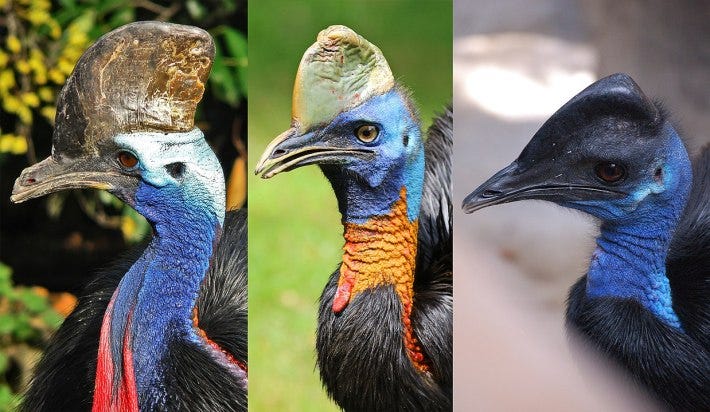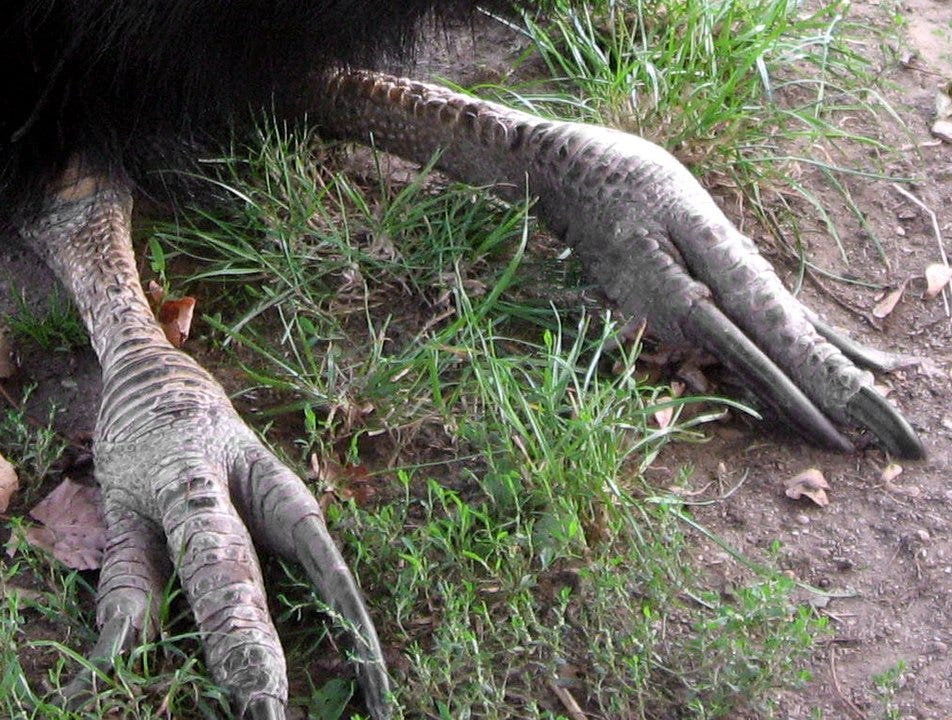
Hello!! Katherine here, longtime bird fan but first time Bird of the Week contributor. What an honor it is to be bringing you a BOTW that's basically (still) more dinosaur than bird: the cassowary.
These guys (I use this as a gender-neutral term) are a wonder to behold! There are three main species: the Southern, Northern, and Dwarf cassowaries, the Southern variety, which is found in southern New Guinea and northeastern Australia, being the most common. This bad boy (gender-neutral, again) is the third-tallest and second-heaviest living species of bird; only ostriches and emus are larger. Adult cassowaries grow to be between five to six feet tall, although females, which grow larger and are more brightly colored, can stand as high as 6.6 ft tall. They're known as shy birds who live in the deep rainforest and lay green eggs. (Goals, amiright??)
But let's talk about the most visible equipment they're packin'. All cassowaries have a casque, or helmet, on their heads, which is covered in keratin, just like our fingernails.
Here's a look at the casques of the three species (from left to right, Southern, Northern, and Dwarf):

There are a number of theories about why cassowaries have this impressive thorn-like crown, including for mating or to help with the acoustics of their low, rumbling call. Here's how the San Diego Zoo characterizes that sound: "Cassowaries also hiss and whistle to communicate, and clap their bills or rumble when making a threat. The rumble is so low and powerful that wildlife care specialists working with the birds report they can feel it in their bones."
Seriously, get a load of this earth-shaking grumble!
But perhaps even MORE notable? Their three-toed feet, which include a middle toe that's repeatedly described in my reading as "dagger-like." From the San Diego Zoo's description (the exclamations are theirs, but I co-sign the sentiment):
The cassowary is rightfully considered the most dangerous bird in the world! Each 3-toed foot has a dagger-like claw on the inner toe that is up to 4 inches (10 centimeters) long! The cassowary can slice open any predator or potential threat with a single swift kick. Powerful legs help the cassowary run up to 31 miles per hour (50 kilometers per hour) through the dense forest underbrush.
A cassowary can also jump nearly 7 feet (2 meters) straight up into the air and swim like a champ, so the bird is quite good at fending off threats or escaping danger! That long claw also comes in handy when digging for fallen fruit in the leaf litter.
Here's a look at those claws:

As you might expect, cassowaries have occasionally tangled with humans, mostly after being offered food (not to victim blame but don't do this!!!) Per Scientific American's blog:
It’s well known that cassowaries can be dangerous, and indeed together with ostriches [UPDATE: and chickens] they are the only birds known to have definitely killed humans*. On mainland Australia, the most recent recorded fatality occurred in April 1926 when 16-year-old Phillip McClean received an injury to the throat after running from a cassowary and falling to the ground. I've also encountered references to the death of a zookeeper named Luke James who was apparently killed by a captive cassowary, but have only read about this online and am not sure as to its reliability (readers: please let me know if have access to any further information on this case).
I believe they're referring to this case, from Florida in 2019, of a man being killed by a cassowary he was breeding. Not my bag, I'll respect them from afar thanks!
While they're clearly dangerous, these majestic birds are endangered, mostly thanks to cars and attacks by dogs, and more than well worth saving: There's research that native populations in New Guinea raised cassowaries almost to maturity as early at 18,000 years ago, their scat helps distribute seeds through the rainforest, and by god, just look at them!!! Nature is incredible.
One last cassowary for the road!

I love them.
A reminder: you can check out our complete Bird of the Week list here, and get in touch with your bird suggestions at hello@discourseblog.com.





